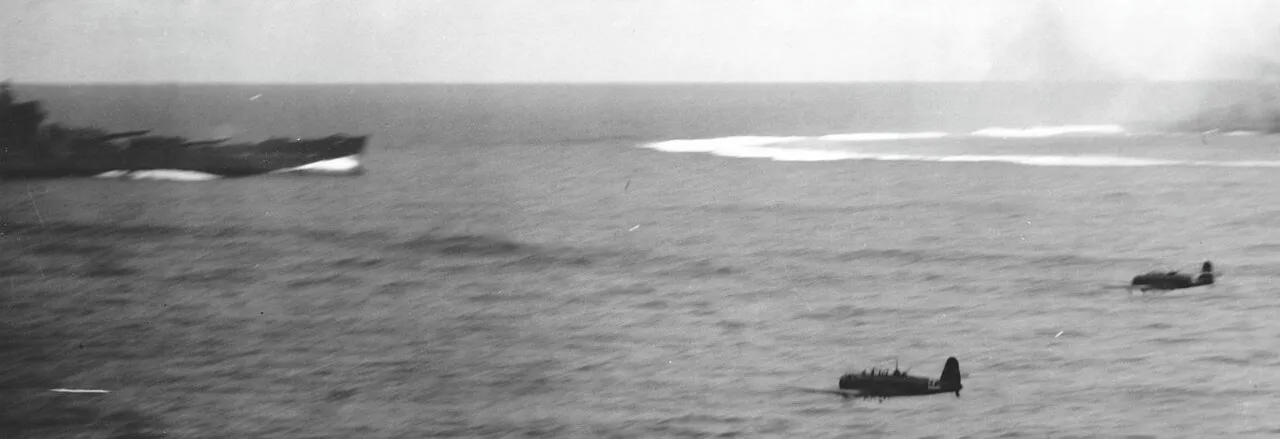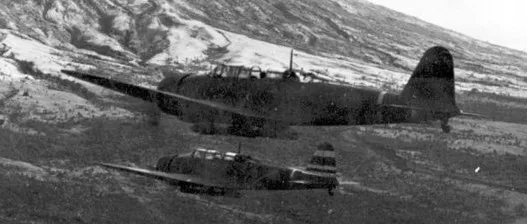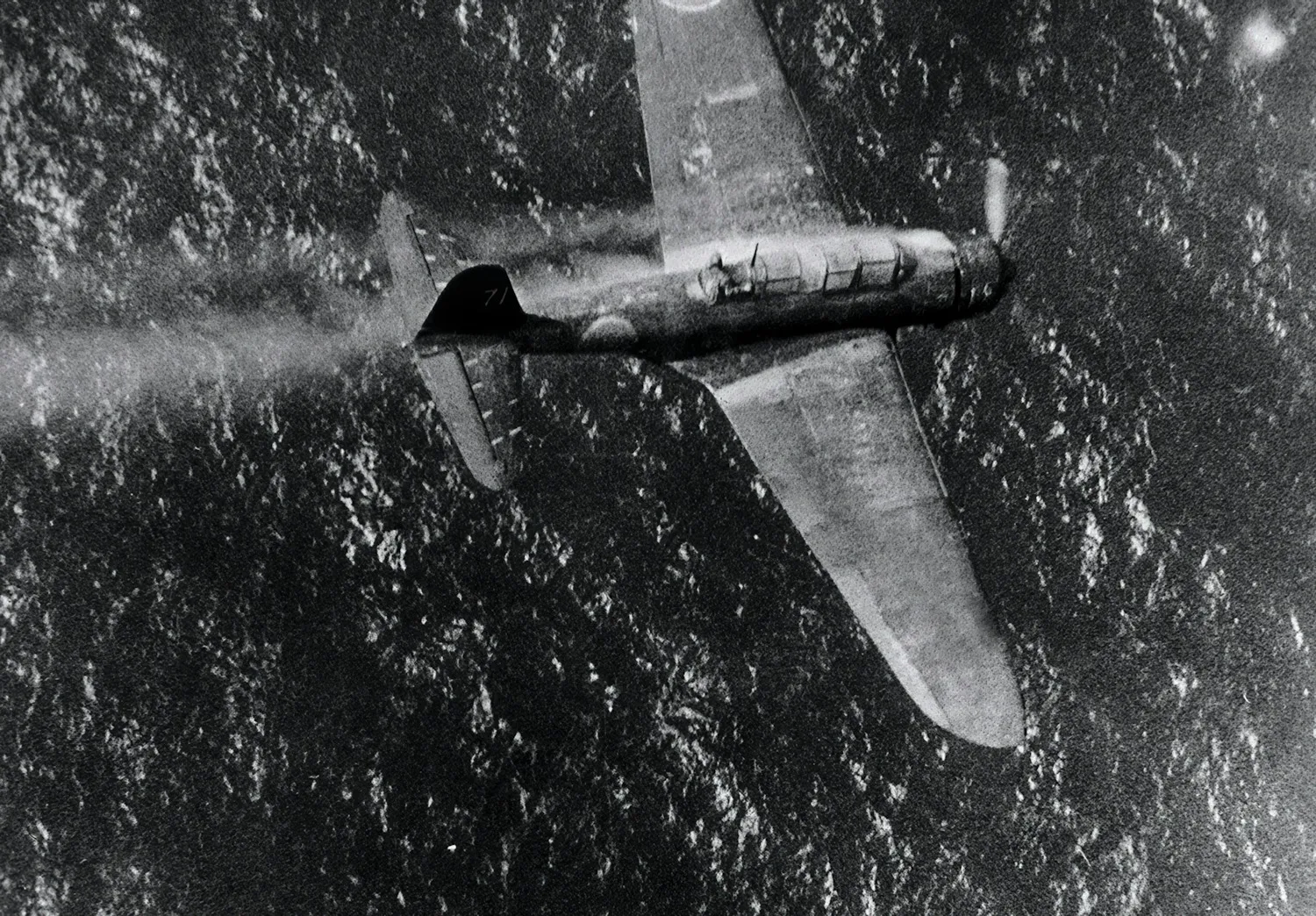Warplanes of Japan: Nakajima B5N
Nakajima B5N

(IJNAF Photo)
The Nakajima B5N (Japanese: 中島 B5N, Allied reporting name "Kate") was the standard carrier-based torpedo bomber of the Imperial Japanese Navy (IJN) for much of the Second World War. It also served as a high level bomber. Although the B5N was substantially faster and more capable than its Alliedcounterparts, the American Douglas TBD Devastator monoplane (the U.S. Navy'sfirst all-metal, carrier-borne monoplane of any type with retracting gear), andthe British Fairey Swordfish and Fairey Albacore torpedo biplanes, it wasnearing obsolescence by 1941. Nevertheless, the B5N operated throughout thewhole war, due to the delayed development of its successor, the B6N. In the early part of the Pacific War, when flown by well-trained IJN aircrewsand as part of well-coordinated attacks, the B5N achieved particular successesat the battles of Pearl Harbor, Coral Sea, Midway, and Santa Cruz Islands.
The B5N was designed by a team led by Katsuji Nakamura in response to a 1935specification by the Navy for a torpedo bomber to replace the Yokosuka B4Y.Internally designated Type K by Nakajima, it successfully competed with theMitsubishi B5M for a production contract. The first prototype flew in January1937 and was ordered into production soon afterwards with the full designationType 97 Carrier Attack Bomber (九七式艦上攻撃機)(kyū-nana-shiki kanjō kōgeki-ki or kankō for short).
Combat experience during the Second Sino-Japanese War revealed several weaknesses in the original B5N1 production model. These were mainly concernedwith the lack of protection that the design offered its crew and its fueltanks. Keen to maintain the high performance of the type, the Navy wasreluctant to add weight in the form of armor, and instead looked to obtaining a faster version of the aircraft in the hopes of outrunning enemy fighters. The B5N2 was given a much more powerful engine - Nakajima's own Sakae Model 11,14-cylinder twin-row radial, as used in the initial models of the MitsubishiA6M fighter – and various modifications were made to streamline it. Althoughi ts performance was only marginally better, and its weaknesses remained unremedied, this version replaced the B5N1 in production and service from 1939.
The navigator/bombardier/observer position was equipped with a Type 90bombsight, which was a long vertical tube located in the front-left of theseat. There was also a Type 3 reflector compass for precise navigation that wasmounted on the top of the cockpit frame. The radio-operator/gunner position wasequipped with one of the standard-issue radio sets for navy three-seateraircraft (Type 96 Mk3 earlier and Type 2 Mk. 3 later) that was mounted in front of the radio-operator/gunner's seat and behind thenavigator/bombardier/observer's seat.
The radio-operator/gunner also operated one flexible 7.7 mm (.303 in) Type 92machine gun at the rear end of the cockpit. One Type 91 torpedo could bemounted on the racks that were fixed eccentrically to the right at the bottomof the fuselage. Alternatively, racks could be replaced to carry either one 800kg bomb (e.g., Type 99 No 80 armor-piercing bomb) or two 250 kg bombs (e.g.,Type 98 No 25 land bomb) or six 60 kg bombs (e.g., Type 2 No 6 land bomb).Replacing the racks and exchanging between the torpedo and bombs was not atrivial process and could take more than two hours to complete. Initially, most of the B5N bombers were painted in silver, which was the colorused throughout the early stages of the Second Sino-Japanese War. The coloureventually changed to dark green before the start of the Pacific War.
The B5N was primarily employed as a carrier-based aircraft and occasionally asa land-based bomber. It carried a crew of three: pilot,navigator/bombardier/observer, and radio-operator/gunner. As with other IJNmulti-seat aircraft, an individual bomber was commanded by the senior rankingcrew member aboard, which could be the observer rather than the pilot. The initial model B5N1 first saw action in the Second Sino-Japanese War in1938. The updated B5N2 played a major role in the Attack on Pearl Harbor. Oneof the B5N2s carried Mitsuo Fuchida, the commander of the attack, with onehigh-level bomber from the carrier Hiryū credited with sinking the Americanbattleship Arizona. The B5N2 torpedo bombers also sank the battleships West Virginia, California, Oklahoma and Utah. Five torpedo bombers were shot down inthe first wave. Apart from this raid, the greatest successes of the B5N2 werethe key roles it played in sinking the United States Navy aircraft carrier Lexington at the Battle of the Coral Sea and the aircraft carrier Hornet at the Battle of the Santa Cruz Islands, and the disabling of the aircraft carrier Yorktown at the Battle of Midway, later sunk by the Japanese submarine I-168.
B5N2 torpedo bombers normally performed a coordinated attack on enemy carrierswith Aichi D3A dive bombers. Ideally, dive bombers would help to suppress theship's anti-aircraft fire, which improved the chances of success for theslow-flying torpedo bombers. During the Battle of the Eastern Solomons, the IJN tried to minimize losses to torpedo bombers and initially sent only the dive bombers to attack and cripple US carriers for the subsequent torpedo strike, this proved unsuccessful, as the torpedo bombers did not launch until the battle was over.
The B5N served as the basis for a follow-on design, the B6N, which eventuallyreplaced it in front-line service. The B5N continued to fly in secondary roles,such as training, target towing, and anti-submarine warfare. Some of theaircraft used for this latter purpose were equipped with early radars andmagnetic anomaly detectors. B5Ns were also used as bombers during the unsuccessful defense of the Philippines in October 1944, suffering severe losses. Later in the war, they were used for kamikaze attacks. (Wikipedia)

(IJNAF Photo)
Nakajima B5N2 "Kate" carrying a 250 kg (550 lb) bomb.

(IJNAF Photo)
Nakajima B5N2 Kate.

(IJNAF Photo)
Nakajima B5N2 Kate.

(IJNAF Photo)
Nakajima B5N1 Kate.
_PDVD_050.webp)
(IJNAF Photo)
Nakajima B5N1 Kate, launching from a carrier in 1942.

(IJNAF Photo)
Nakajima B5N1 torpedo bomber code-named "Kate" taking off from the Imperial Japanese Navy aircraft carrier Zuikaku to attack Pearl Harbor, Hawaii, on 7 December 1941.
_on_26_October_1942.webp)
(USN Photo)
A Japanese Nakajima B5N2 "Kate" torpedo aircraft (visible just above and to the right of carrier's island) drops a torpedo (splash at lower right) that will hit the U.S. Navy aircraft carrier USS Hornet (CV-8) and cause fatal damage on 26 October 1942.
_on_4_June_1942.webp)
(USN Photo)
Two Type 97 shipboard attack aircraft from the Japanese aircraft carrier Hiryu fly past the U.S. Navy carrier USS Yorktown (CV-5), after dropping their torpedoes during the mid-afternoon attack, 4 June 1942. Note the heavy anti-aircraft fire. The destroyer at left, just beyond Yorktown´s bow, is probably USS Morris (DD-417).

(USN Photo)
The U.S. Navy battleship USS South Dakota (BB-57) firing her anti-aircraft guns at attacking Japanese planes during the Battle of Santa Cruz, 26 October 1942. A Japanese Type 97 Nakajima B5N2 torpedo plane ("Kate") is visible at right, apparently leaving the area after having dropped its torpedo.

(USN Photo)
Two Japanese Nakajima B5N2 Kate torpedo bombers fly near the U.S. battleship USS South Dakota (BB-57) during the Battle of Santa Cruz Islands on 26 October 1942 in the Southwest Pacific.

(IJNAF Photo)
Type 97 Carrier Attack Bombers (B5N1) "Kate" from the aircraft carrier Ryujo.

(IJNAF Photo)
After repairs to the damage from the Battle of the Santa Cruz Islands, Imperial Japanese Navy carrier Shōkaku; lands a Type 97 bomber in preparation for continued operations against US naval forces in the south Pacific.

(USN Photo)
Nakajima B5N2 (Navy Type 97 Carrier Attack Bomber Model 1), codename “Kate.

(USN Photo)
Nakajima B5N Kate trailiing smoke as it plummets toward the sea near Truk, 2 July 1944, after being hit by a Navy PB4Y. USN LCdr William Janeshek observed the gunner stand as if to bail out—then sit back down, motionless, moments before the crash. Lou Matthews noted "it is gtoo low to bail out and a quick death beats a long lingering one. Sharks, drowning, lack of water. He summed it up and took option A.

(USN Photo)
Nakajima B5N2 Kate, green cross surrender markings.

(RNZAF Photo)
Nakajima B5N2 Kate, No. 302, RNZAF, captured in Sep 1945 at Rabaul.





(USAAF Photos)
Nakajima B5N2 Navy Type 97 Carrier Attack Bomber Model 1, (Serial No. 2194), codenamed “Kate”, TAIC 6 flying out of NAS Anacostia. This aircraft was scrapped in 1946.
Nakajima B5N





